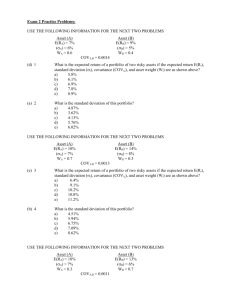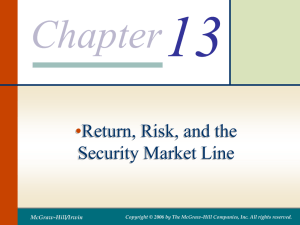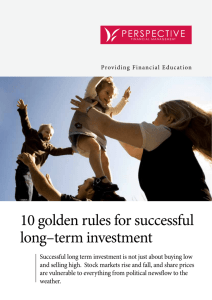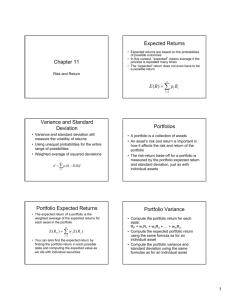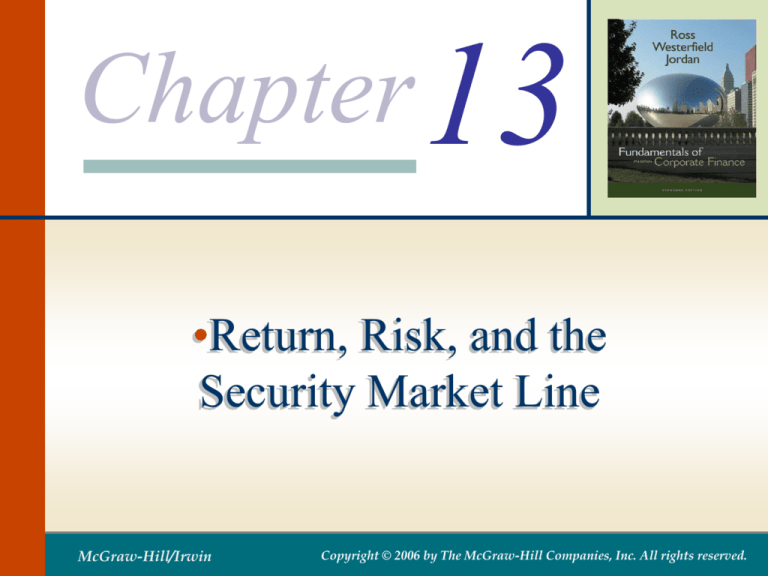
Chapter 13
•Return, Risk, and the
Security Market Line
McGraw-Hill/Irwin
Copyright © 2006 by The McGraw-Hill Companies, Inc. All rights reserved.
Key Concepts and Skills
•
•
•
•
•
•
Know how to calculate expected returns
Understand the impact of diversification
Understand the systematic risk principle
Understand the security market line
Understand the risk-return trade-off
Be able to use the Capital Asset Pricing
Model
13-1
Chapter Outline
• Expected Returns and Variances
• Portfolios
• Announcements, Surprises, and Expected
Returns
• Risk: Systematic and Unsystematic
• Diversification and Portfolio Risk
• Systematic Risk and Beta
• The Security Market Line
• The SML and the Cost of Capital: A Preview
13-2
風險(Risk)
基本風險:
‧政治風險
‧總體經濟風險
‧社會風險
‧戰爭、天災
個別風險:
‧遭竊盜、火災等意外事件
‧企業重要關係人之風險
‧客戶發生財務危機或破產
企
營運風險:
‧銷售價格及數量風險
‧成本風險
‧營運槓桿風險
‧資產管理風險
業
財務風險:
‧負債風險
‧投資專案風險
‧金融商品投資風險
企業面臨之風險
13-3
13-4
Expected Returns
• Expected returns are based on the
probabilities of possible outcomes
• In this context, “expected” means average
if the process is repeated many times
• The “expected” return does not even have
to be a possible return
n
E ( R) pi Ri
i 1
13-5
Example: Expected Returns
• Suppose you have predicted the following
returns for stocks C and T in three possible
states of nature. What are the expected
returns?
• State
Probability
C
• Boom
0.3
15
• Normal
0.5
10
• Recession ???
2
• RC = .3(15) + .5(10) + .2(2) = 9.99%
• RT = .3(25) + .5(20) + .2(1) = 17.7%
T
25
20
1
13-6
Variance and Standard Deviation
• Variance and standard deviation still
measure the volatility of returns
• Using unequal probabilities for the entire
range of possibilities
• Weighted average of squared deviations
n
σ 2 pi ( Ri E ( R)) 2
i 1
13-7
Example: Variance and Standard
Deviation
• Consider the previous example. What are the
variance and standard deviation for each stock?
• Stock C
• 2 = .3(15-9.9)2 + .5(10-9.9)2 + .2(2-9.9)2 = 20.29
• = 4.5
• Stock T
• 2 = .3(25-17.7)2 + .5(20-17.7)2 + .2(1-17.7)2 =
74.41
• = 8.63
13-8
Another Example
• Consider the following information:
•
•
•
•
•
State
Boom
Normal
Slowdown
Recession
Probability ABC, Inc. (%)
.25
15
.50
8
.15
4
.10
-3
• What is the expected return?
• What is the variance?
• What is the standard deviation?
13-9
Portfolios
• A portfolio is a collection of assets
• An asset’s risk and return are important in
how they affect the risk and return of the
portfolio
• The risk-return trade-off for a portfolio is
measured by the portfolio expected return
and standard deviation, just as with
individual assets
13-10
Example: Portfolio Weights
• Suppose you have $15,000 to invest and
you have purchased securities in the
following amounts. What are your portfolio
weights in each security?
•
•
•
•
$2000 of DCLK
$3000 of KO
$4000 of INTC
$6000 of KEI
•DCLK: 2/15 = .133
•KO: 3/15 = .2
•INTC: 4/15 = .267
•KEI: 6/15 = .4
13-11
Portfolio Expected Returns
• The expected return of a portfolio is the weighted
average of the expected returns for each asset in
the portfolio
m
E ( RP ) w j E ( R j )
j 1
• You can also find the expected return by finding
the portfolio return in each possible state and
computing the expected value as we did with
individual securities
13-12
Example: Expected Portfolio
Returns
• Consider the portfolio weights computed
previously. If the individual stocks have the
following expected returns, what is the expected
return for the portfolio?
•
•
•
•
DCLK: 19.69%
KO: 5.25%
INTC: 16.65%
KEI: 18.24%
• E(RP) = .133(19.69) + .2(5.25) + .167(16.65)
+ .4(18.24) = 13.75%
13-13
Portfolio Variance
• Compute the portfolio return for each state:
RP = w1R1 + w2R2 + … + wmRm
• Compute the expected portfolio return
using the same formula as for an individual
asset
• Compute the portfolio variance and
standard deviation using the same
formulas as for an individual asset
13-14
Example: Portfolio Variance
• Consider the following information
•
•
•
•
Invest 50% of your money in Asset A
Portfolio
State Probability A
B
12.5%
Boom .4
30%
-5%
Bust .6
-10%
25% 7.5%
• What are the expected return and standard
deviation for each asset?
• What are the expected return and standard
deviation for the portfolio?
13-15
Another Example
• Consider the following information
•
•
•
•
State
Boom
Normal
Recession
Probability
.25
.60
.15
X
15%
10%
5%
Z
10%
9%
10%
• What are the expected return and standard
deviation for a portfolio with an investment
of $6000 in asset X and $4000 in asset Z?
13-16
認識投資組合
• 由一種以上的證券或資產構成的集合稱
為投資組合
• 投資組合的預期報酬率
• 為所有個別資產預期報酬率的加權平均數
E(Ri) W1 R1 W2 R 2 ... Wn Rn
13-17
投資組合的風險
• 以標準差或變異係數來衡量。投資組合
的標準差,必 須先求得總合變異數,再
開根號才能得到標準差。
• 以兩種資產為例
2
2
Var ( W1R 1 W2 R 2 ) W1 Var ( R 1 ) W2 Var ( R 2 )
2 W1 W2 Cov ( R 1 , R 2 )
13-18
Expected versus Unexpected
Returns
• Realized returns are generally not equal to
expected returns
• There is the expected component and the
unexpected component
• At any point in time, the unexpected return can
be either positive or negative
• Over time, the average of the unexpected
component is zero
13-19
Announcements and News
• Announcements and news contain both an
expected component and a surprise
component
• It is the surprise component that affects a
stock’s price and therefore its return
• This is very obvious when we watch how
stock prices move when an unexpected
announcement is made or earnings are
different than anticipated
13-20
Efficient Markets
• Efficient markets are a result of investors
trading on the unexpected portion of
announcements
• The easier it is to trade on surprises, the
more efficient markets should be
• Efficient markets involve random price
changes because we cannot predict
surprises
13-21
Systematic Risk
• Risk factors that affect a large number of
assets
• Also known as non-diversifiable risk or
market risk
• Includes such things as changes in GDP,
inflation, interest rates, etc.
13-22
Unsystematic Risk
• Risk factors that affect a limited number of
assets
• Also known as unique risk and assetspecific risk
• Includes such things as labor strikes, part
shortages, etc.
13-23
Returns
• Total Return = expected return +
unexpected return
• Unexpected return = systematic portion +
unsystematic portion
• Therefore, total return can be expressed as
follows:
• Total Return = expected return +
systematic portion + unsystematic portion
13-24
Diversification
• Portfolio diversification is the investment in
several different asset classes or sectors
• Diversification is not just holding a lot of
assets
• For example, if you own 50 internet stocks,
you are not diversified
• However, if you own 50 stocks that span
20 different industries, then you are
diversified
13-25
Table 13.7
13-26
證券投資組合之報酬率與風險
13-27
證券組合 AB
報酬率
15.00
10.00
A
5.00
%
B 月
0.00
-5.00 1
2
3
4
5
6
= 7.61%
A標準差
= 3.81%
B 標準差
-10.00
-15.00
A 與 B 證券之報酬率
報酬率
15.00
證券組合 0.5A +0.5B
10.00
5.00
%
0.00
-5.00
1
2
3
4
5
6
-10.00
標準差 = 5.71%
-15.00
AB 證券投資組合之報酬率
13-28
證券組合 AC
報酬率
15.00
10.00
5.00
%
C
0.00
-5.00
1
2
3
4
5
6
A
-10.00
A 標準差 = 7.61%
-15.00
C 標準差 = 7.61%
A 與 C 證券之報酬率
報酬率
15.00
10.00
證券組合 0.5A +0.5C
5.00
%
0.00
-5.00
-10.00
1
2
3
4
5
6
標準差 = 0
-15.00
AC 證券投資組合之報酬率
13-29
證券的相關性
A、B 證券組合之報酬率
個股
月
1
2
3
4
5
6
均數
標準差
A
證券組合
%
B
8.80
8.02
-3.50
9.48
-7.80
9.00
4.00
7.61
0.8A+0.2B 0.6A+0.4B 0.4A+0.6B 0.2A+0.8B
4.40
7.92
7.04
6.16
5.28
4.01
7.22
6.42
5.61
4.81
-1.75
-3.15
-2.80
-2.45
-2.10
4.74
8.53
7.58
6.64
5.69
-3.90
-7.02
-6.24
-5.46
-4.68
4.50
8.10
7.20
6.30
5.40
2.00
3.81
3.60
6.85
3.20
6.09
報酬率
4.00
2.80
5.33
2.40
4.57
0.8A+0.2B
0.6A+0.4B
0.4A+0.6B
0.2A+0.8B
2.00
A與B之相關係數為1
風險
0.00
0.00
1.00
2.00
3.00
4.00
5.00
6.00
7.00
A、B 證券組合之報酬率與風險
13-30
A、C 證券組合之報酬率
個股
月
1
2
3
4
5
6
均數
標準差
A
證券組合
%
C
0.8A+0.2C 0.6A+0.4C 0.4A+0.6C 0.2A+0.8C
-3.80
6.28
3.76
1.24
-1.28
-3.02
5.81
3.60
1.40
-0.81
8.50
-1.10
1.30
3.70
6.10
-4.48
6.69
3.90
1.10
-1.69
12.80
-3.68
0.44
4.56
8.68
-4.00
6.40
3.80
1.20
-1.40
8.80
8.02
-3.50
9.48
-7.80
9.00
4.00
7.61
1.00
7.61
3.40
4.57
2.80
1.52
報酬率
4.00
2.20
1.52
1.60
4.57
0.8A+0.2C
0.6A+0.4C
0.5A+0.5C
2.00
0.4A+0.6C
0.2A+0.8C
A與C證券相關係數為- 1
0.00
0.00
1.00
2.00
3.00
風險
4.00
5.00
A、C 證券組合之報酬率與風險
13-31
(7-10a)
(7-10b)
13-32
兩種證券之相關係數與風險
證券組合報
酬率 E(R)
%
降低風險
增
加
‧X
Y
xy = -1.0
xy = 1.0
xy= 0
xy = -1.0
‧
Y
0
證
券
的
權
數
證券組合風險
兩種證券之相關係數與風險
13-33
多角化的內涵
相關係數為+1(完全正相關)
相關係數介於±1時,相關係數愈
時,增加資產數目,僅會重新
小,風險分散效果愈大,故風險
調 整風險結構,無風險分散效
愈小。
果。
相關係數為-1(完全負相關)
時此時風險在各種相關係數中
為最小,風險分散效果可達最
大,甚至可構成零風險的投資
組合。
綜合以上三種情形的
討論,可發現以增加
投資標的、建構投資
組合來降低投資所面
臨的風險,稱之為多
角化。
13-34
The Principle of Diversification
• Diversification can substantially reduce the
variability of returns without an equivalent
reduction in expected returns
• This reduction in risk arises because worse
than expected returns from one asset are
offset by better than expected returns from
another
• However, there is a minimum level of risk
that cannot be diversified away and that is
the systematic portion
13-35
Figure 13.1
13-36
風險分散的極限
系統風險
所有資產必須共同面對的
風險,無法透過多角化加
以分散,又稱為市場風險
。如貨幣與財政政策對
GNP的衝擊、通貨膨脹的
現象、國內政局不安等因
素等。
非系統風險
可以在多角化過程
風
險
中被分散掉的風險
。如罷工、新產品
開發、專利權、董
監事成員、股權結
構改變等。
風險分散的極限
隨著投資組合中資產數目的增加,非系統風險逐
漸減少,系統風險則保持不變;直到非系統風險
消除殆盡時,總風險將等於系統風險。
13-37
Diversifiable Risk
• The risk that can be eliminated by
combining assets into a portfolio
• Often considered the same as
unsystematic, unique or asset-specific risk
• If we hold only one asset, or assets in the
same industry, then we are exposing
ourselves to risk that we could diversify
away
13-38
Total Risk
• Total risk = systematic risk + unsystematic
risk
• The standard deviation of returns is a
measure of total risk
• For well-diversified portfolios, unsystematic
risk is very small
• Consequently, the total risk for a diversified
portfolio is essentially equivalent to the
systematic risk
13-39
Systematic Risk Principle
• There is a reward for bearing risk
• There is not a reward for bearing risk
unnecessarily
• The expected return on a risky asset
depends only on that asset’s systematic
risk since unsystematic risk can be
diversified away
13-40
Table 13.8
13-41
Measuring Systematic Risk
• How do we measure systematic risk?
• We use the beta coefficient to measure
systematic risk
• What does beta tell us?
• A beta of 1 implies the asset has the same
systematic risk as the overall market
• A beta < 1 implies the asset has less
systematic risk than the overall market
• A beta > 1 implies the asset has more
systematic risk than the overall market
13-42
Total versus Systematic Risk
• Consider the following information:
• Security C
• Security K
Standard Deviation
20%
30%
Beta
1.25
0.95
• Which security has more total risk?
• Which security has more systematic risk?
• Which security should have the higher
expected return?
13-43
Work the Web Example
• Many sites provide betas for companies
• Yahoo Finance provides beta, plus a lot of
other information under its key statistics
link
• Click on the web surfer to go to Yahoo
Finance
• Enter a ticker symbol and get a basic quote
• Click on key statistics
13-44
Example: Portfolio Betas
• Consider the previous example with the following
four securities
•
•
•
•
•
Security
DCLK
KO
INTC
KEI
Weight
.133
.2
.167
.4
Beta
2.685
0.195
2.161
2.434
• What is the portfolio beta?
• .133(2.685) + .2(.195) + .167(2.161) + .4(2.434)
= 1.731
13-45
Beta and the Risk Premium
• Remember that the risk premium =
expected return – risk-free rate
• The higher the beta, the greater the risk
premium should be
• Can we define the relationship between
the risk premium and beta so that we can
estimate the expected return?
• YES!
13-46
Example: Portfolio Expected
Returns and Betas
30%
Expected Return
25%
E(RA)
20%
15%
10%
Rf
5%
0%
0
0.5
1
1.5A
2
2.5
3
Beta
13-47
Reward-to-Risk Ratio: Definition
and Example
• The reward-to-risk ratio is the slope of the
line illustrated in the previous example
• Slope = (E(RA) – Rf) / (A – 0)
• Reward-to-risk ratio for previous example =
(20 – 8) / (1.6 – 0) = 7.5
• What if an asset has a reward-to-risk ratio
of 8 (implying that the asset plots above
the line)?
• What if an asset has a reward-to-risk ratio
of 7 (implying that the asset plots below
the line)?
13-48
Market Equilibrium
• In equilibrium, all assets and portfolios
must have the same reward-to-risk ratio
and they all must equal the reward-to-risk
ratio for the market
E ( RA ) R f
A
E ( RM R f )
M
13-49
Security Market Line
• The security market line (SML) is the
representation of market equilibrium
• The slope of the SML is the reward-to-risk
ratio: (E(RM) – Rf) / M
• But since the beta for the market is
ALWAYS equal to one, the slope can be
rewritten
• Slope = E(RM) – Rf = market risk premium
13-50
The Capital Asset Pricing Model
(CAPM)
• The capital asset pricing model defines the
relationship between risk and return
• E(RA) = Rf + A(E(RM) – Rf)
• If we know an asset’s systematic risk, we
can use the CAPM to determine its
expected return
• This is true whether we are talking about
financial assets or physical assets
13-51
Factors Affecting Expected
Return
• Pure time value of money – measured by
the risk-free rate
• Reward for bearing systematic risk –
measured by the market risk premium
• Amount of systematic risk – measured by
beta
13-52
Example - CAPM
• Consider the betas for each of the assets given
earlier. If the risk-free rate is 2.13% and the
market risk premium is 8.6%, what is the
expected return for each?
Security
DCLK
KO
INTC
KEI
Beta
2.685
0.195
2.161
2.434
Expected Return
2.13 + 2.685(8.6) = 25.22%
2.13 + 0.195(8.6) = 3.81%
2.13 + 2.161(8.6) = 20.71%
2.13 + 2.434(8.6) = 23.06%
13-53
Figure 13.4
13-54
Quick Quiz
• How do you compute the expected return and
standard deviation for an individual asset? For a
portfolio?
• What is the difference between systematic and
unsystematic risk?
• What type of risk is relevant for determining the
expected return?
• Consider an asset with a beta of 1.2, a risk-free
rate of 5% and a market return of 13%.
• What is the reward-to-risk ratio in equilibrium?
• What is the expected return on the asset?
13-55
Chapter 13
•End of Chapter
McGraw-Hill/Irwin
Copyright © 2006 by The McGraw-Hill Companies, Inc. All rights reserved.



